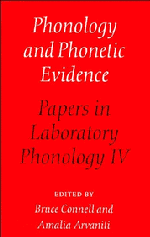Book contents
- Frontmatter
- Contents
- List of contributors
- Acknowledgments
- 1 Introduction
- I Features and Perception
- II Prosody
- III Articulatory Organization
- 15 Prosodic patterns in the coordination of vowel and consonant gestures
- 16 “Where” is timing? Comments on Smith
- 17 Asymmetrical prosodic effects on the laryngeal gesture in Korean
- 18 On a gestural account of lenis stop voicing in Korean: comments on Jun
- 19 A production and perceptual account of palatalization
- 20 An acoustic and electropalatographic study of lexical and postlexical palatalization in American English
- 21 What do we do when phonology is powerful enough to imitate phonetics? Comments on Zsiga
- 22 The influence of syntactic structure on [s] to [∫] assimilation
- 23 Assimilation as gestural overlap: comments on Hoist and Nolan
- 24 Orals, gutturals, and the jaw
- 25 The role of the jaw — active or passive? Comments on Lee
- 26 The phonetics and phonology of glottalized consonants in Lendu
- 27 Lendu consonants and the role of overlapping gestures in sound change: comments on Demolin
- Subject index
- Index of names
- Index of languages
15 - Prosodic patterns in the coordination of vowel and consonant gestures
Published online by Cambridge University Press: 03 May 2011
- Frontmatter
- Contents
- List of contributors
- Acknowledgments
- 1 Introduction
- I Features and Perception
- II Prosody
- III Articulatory Organization
- 15 Prosodic patterns in the coordination of vowel and consonant gestures
- 16 “Where” is timing? Comments on Smith
- 17 Asymmetrical prosodic effects on the laryngeal gesture in Korean
- 18 On a gestural account of lenis stop voicing in Korean: comments on Jun
- 19 A production and perceptual account of palatalization
- 20 An acoustic and electropalatographic study of lexical and postlexical palatalization in American English
- 21 What do we do when phonology is powerful enough to imitate phonetics? Comments on Zsiga
- 22 The influence of syntactic structure on [s] to [∫] assimilation
- 23 Assimilation as gestural overlap: comments on Hoist and Nolan
- 24 Orals, gutturals, and the jaw
- 25 The role of the jaw — active or passive? Comments on Lee
- 26 The phonetics and phonology of glottalized consonants in Lendu
- 27 Lendu consonants and the role of overlapping gestures in sound change: comments on Demolin
- Subject index
- Index of names
- Index of languages
Summary
Both autosegmental representations (e.g. McCarthy, 1981, 1982, 1989; Prince, 1987; Archangeli, 1985; Steriade, 1986) and analyses of articulatory and acoustic data (e.g. Joos, 1948; Öhman, 1966, 1967; Fowler, 1980, 1981, 1983) suggest that vowels and consonants can appear independent of one another. In phenomena such as vowel harmony, phonological processes involving vowels sometimes operate as if an intervocalic consonant were absent; likewise, consonantal harmony processes or co-occurrence restrictions may ignore intervening vowels. In speech production, it has been suggested that there are distinct, identifiable vowels and consonants, but that the two classes of sounds may be produced at least partially simultaneously. It is hypothesized that these periods of simultaneous production (“coproduction”, as discussed in Fowler, 1980) are responsible for the context-dependent influences of vowels on consonants, and vice versa.
This study focuses on the organization of the temporal relations between vowels and consonants. It is proposed that languages may choose among alternative ways of coordinating vowels and consonants, and that these alternatives underlie differing prosodic properties that languages exhibit, such as the timing patterns traditionally described as stress-, syllable- or mora-timing. The approach taken here involves defining consonants and vowels in terms of articulatory gestures, following Browman and Goldstein's Articulatory Phonology (e.g. Browman & Goldstein, 1986, 1992). This framework provides a phonological description that explicitly specifies how consonants and vowels are produced, making it possible to predict how differences in articulatory coordination could result in different prosodic characteristics.
- Type
- Chapter
- Information
- Phonology and Phonetic EvidencePapers in Laboratory Phonology IV, pp. 205 - 222Publisher: Cambridge University PressPrint publication year: 1995
- 20
- Cited by



